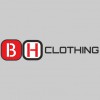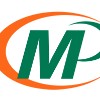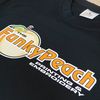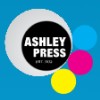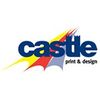
If your design needs to have a bleed then it's important to allow 3mm overlap (see image A below). As the letterhead will be printed on oversize material (SRA4), this gives the guillotine operator a chance to cut into the artwork and produce a good finished letterhead. If the artwork ended at the edge of the sheet and the guillotine cut was only 0.5mm out, then we could end up with an unsightly thin white strip down one edge of the sheet, which is not ideal.
Also, if there is a large stack of paper on the press, with the best will in the world there will be the odd sheet that doesn't get fed through the press 100% accurately so if a bleed hasn't been put in place this could cause issues. Extending the artwork over the edge of the sheet allows for a little leeway when it comes to the time for trimming.
If you've set your workspace for A4 and intend to use bleeds then, depending on what software package you are using you may need to set the workspace to oversize A4 (SRA4), which measures 225mm x 320mm.
Also, if there is a large stack of paper on the press, with the best will in the world there will be the odd sheet that doesn't get fed through the press 100% accurately so if a bleed hasn't been put in place this could cause issues. Extending the artwork over the edge of the sheet allows for a little leeway when it comes to the time for trimming.
If you've set your workspace for A4 and intend to use bleeds then, depending on what software package you are using you may need to set the workspace to oversize A4 (SRA4), which measures 225mm x 320mm.
Services
Castle Print & Design started life in 1992 and was based in Newbury, Berkshire.
For a number of years, we were 'stationed' at RAF Greenham Common which, at that time, had recently been turned into a business park.
It was a fascinating place to be based as many of the original features were still intact, such as the courtroom opposite us and the nuclear silos on the perimeter.
Our own building, which was the Commanders Office, was complete with 2 huge flagpoles, (which we put into good use!) and an enormous walk-in safe which wouldn't have been out of place in a high street bank!
For a number of years, we were 'stationed' at RAF Greenham Common which, at that time, had recently been turned into a business park.
It was a fascinating place to be based as many of the original features were still intact, such as the courtroom opposite us and the nuclear silos on the perimeter.
Our own building, which was the Commanders Office, was complete with 2 huge flagpoles, (which we put into good use!) and an enormous walk-in safe which wouldn't have been out of place in a high street bank!
If you're considering designing your own booklet then it's worth checking to see whether the format you will be supplying the booklet in is usable.
Probably the easiest way, if this is your first booklet, is to design each page in order.
For instance, if you're using Word as an example then just start by designing the front cover on page 1, back cover on page 2, the first inner page on page 3 etc.
Carry on putting your dummy booklet together until you end up with the complete set of pages.
If you are using a professional layout program such as Adobe In-Design or QuarkXpress then an easy way to identify your pages, whilst putting together the booklet, is to put the page numbers to the left and right hand sides of the workspace, (so it doesn't get printed), in large lettering.
Probably the easiest way, if this is your first booklet, is to design each page in order.
For instance, if you're using Word as an example then just start by designing the front cover on page 1, back cover on page 2, the first inner page on page 3 etc.
Carry on putting your dummy booklet together until you end up with the complete set of pages.
If you are using a professional layout program such as Adobe In-Design or QuarkXpress then an easy way to identify your pages, whilst putting together the booklet, is to put the page numbers to the left and right hand sides of the workspace, (so it doesn't get printed), in large lettering.
As with buying white goods for instance, there are many 'box-shifters' in our industry also, who operate by getting work in and out of the door as quickly as possible, with no thought of whether the client is getting the 'right' product.
Taking printed stationery in general, brochures can be one of the most expensive items you ever purchase so it is particularly important you choose the right supplier.
One who will advise on the various options relating to materials, ink colours, special effects etc.
Taking printed stationery in general, brochures can be one of the most expensive items you ever purchase so it is particularly important you choose the right supplier.
One who will advise on the various options relating to materials, ink colours, special effects etc.
Enhance your business cards with a die-cut shaped design, litho printed on superb 400gsm board and matt laminated both sides.
The 6 shapes shown above are our standard cutter shapes.
If you have a requirement for something different - car, van, motorcycle, cup, piece of fruit, lightbulb or any reasonable shape you can think of, then please contact us, as we should be able to help.
If you've got an idea for a shape then you can always send it in to us and we'll advise if it's possible to produce this.
The 6 shapes shown above are our standard cutter shapes.
If you have a requirement for something different - car, van, motorcycle, cup, piece of fruit, lightbulb or any reasonable shape you can think of, then please contact us, as we should be able to help.
If you've got an idea for a shape then you can always send it in to us and we'll advise if it's possible to produce this.
If you are looking for superb results then a matte or gloss laminated business card printed on a superb 400gsm Silk board may be just what you need!
More and more companies are appearing on the web selling so-called 'laminated cards' at vastly reduced prices that seem too good to be true.
In many cases, it is too good to be true.
The process used is to print directly onto very thin paper (using a toner-based digital machine, not litho) and then to encapsulate in a thicker plastic pouch.
These 'cards' are very inexpensive to produce and consequently can sell for up to third of top-quality true laminated cards.
More and more companies are appearing on the web selling so-called 'laminated cards' at vastly reduced prices that seem too good to be true.
In many cases, it is too good to be true.
The process used is to print directly onto very thin paper (using a toner-based digital machine, not litho) and then to encapsulate in a thicker plastic pouch.
These 'cards' are very inexpensive to produce and consequently can sell for up to third of top-quality true laminated cards.
Reviews

Be the first to review Castle Print & Design.
Write a Review
